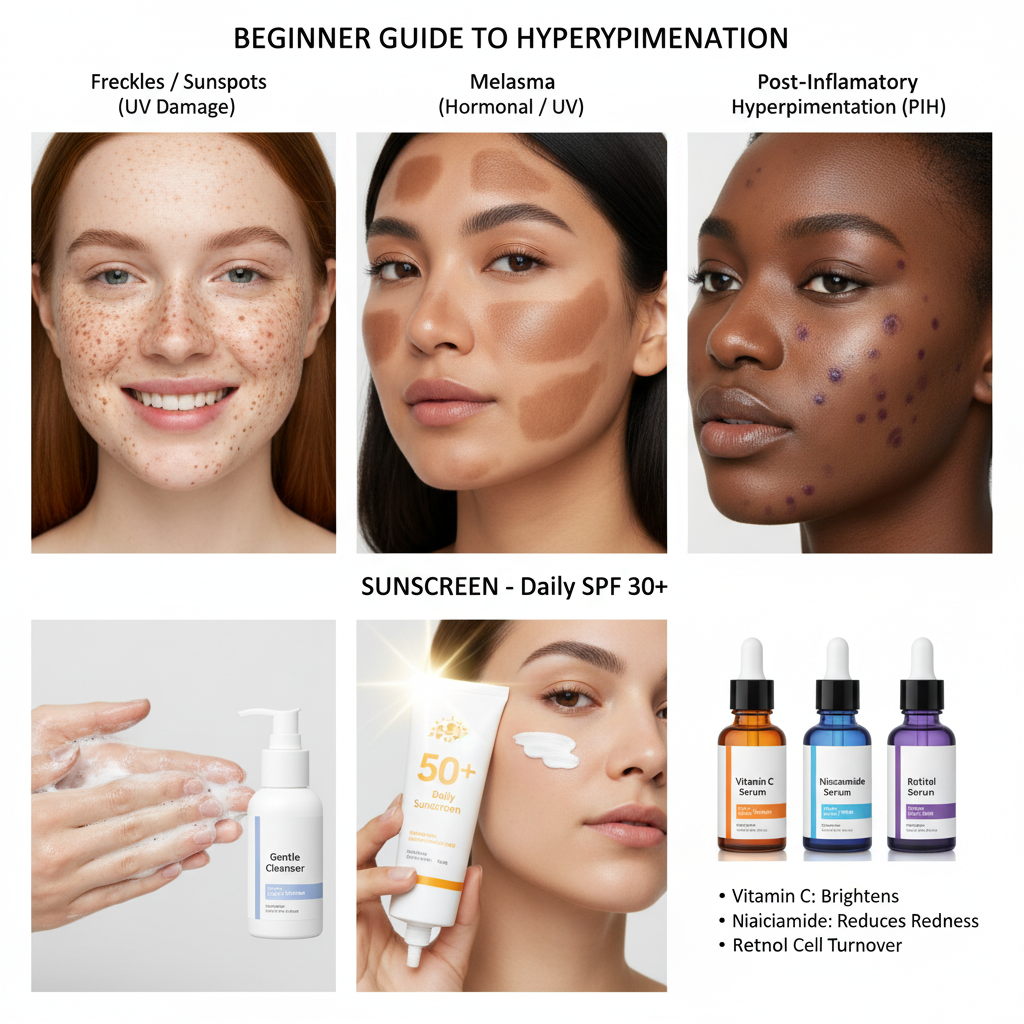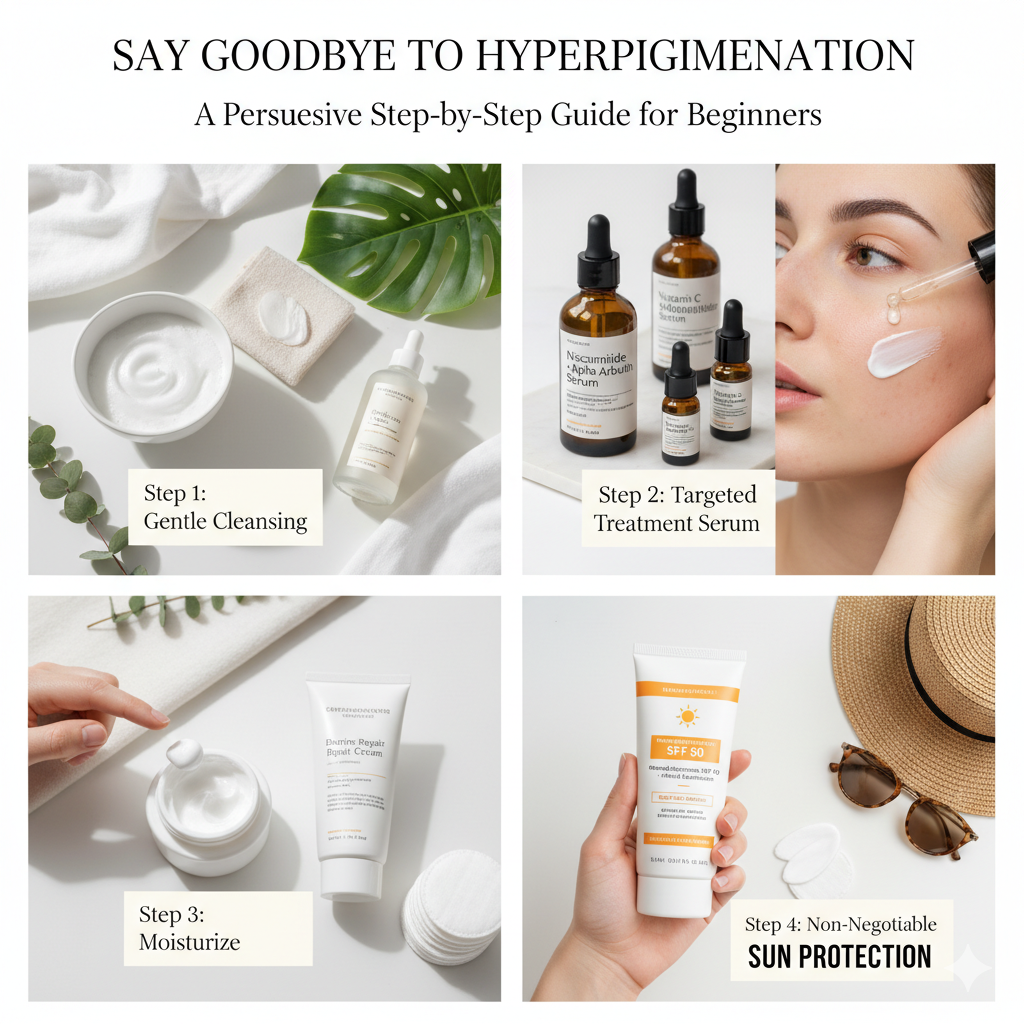Say Goodbye to Hyperpigmentation A Persuasive Step-by-Step Guide for Beginners
What Is Hyperpigmentation and Why You Shouldn’t Ignore It
Hyperpigmentation is one of the most common skin concerns worldwide, affecting millions of people regardless of age, gender, or skin tone. At its core, hyperpigmentation happens when your skin produces too much melanin—the pigment responsible for your skin’s color. This overproduction results in dark spots, uneven patches, or widespread discoloration.
While many dismiss hyperpigmentation as a “cosmetic issue,” the truth is, it can take a serious toll on your confidence, self-esteem, and even your social life. If you’ve ever avoided taking selfies, worn extra makeup to hide dark spots, or felt embarrassed in bright lighting, you know exactly how overwhelming this condition can feel.
Ignoring hyperpigmentation only makes things worse. Over time, dark spots deepen, become harder to treat, and can even signal underlying health or hormonal imbalances. The sooner you take action, the better your chances of reversing it and regaining the smooth, radiant skin you deserve.
Common Causes of Hyperpigmentation
Hyperpigmentation doesn’t appear out of nowhere—it’s often triggered by specific lifestyle, environmental, or internal factors. Let’s break down the most common causes beginners need to understand before starting their treatment journey.
Sun Exposure and UV Damage
UV rays are the number one enemy of even-toned skin. Prolonged sun exposure damages skin cells and triggers excess melanin production, leaving behind freckles, sunspots, or stubborn dark patches.
Hormonal Imbalances and Melasma
Hormonal fluctuations—especially during pregnancy, menopause, or while taking birth control—can lead to melasma, a type of hyperpigmentation characterized by symmetrical patches on the face.
Acne Scars and Post-Inflammatory Marks
If you’ve battled acne, you might notice dark spots that linger long after breakouts heal. This is known as post-inflammatory hyperpigmentation (PIH), and it’s particularly common in people with medium to darker skin tones.
Aging and Lifestyle Factors
Aging naturally slows down skin regeneration, making dark spots more noticeable. Unhealthy habits like smoking, lack of sleep, poor diet, and stress also worsen hyperpigmentation over time.
Step 1: Identify Your Type of Hyperpigmentation
Before you jump into treatments, it’s crucial to identify what kind of hyperpigmentation you’re dealing with.
How to Tell Which Spots You Have
Freckles or sunspots? Likely caused by UV damage.
Symmetrical patches on cheeks or forehead? Probably melasma.
Dark marks after pimples heal? That’s post-inflammatory hyperpigmentation.
When to Seek a Dermatologist’s Help
If your dark patches appear suddenly, worsen quickly, or cover large areas, it’s best to consult a dermatologist. They can diagnose the exact type and recommend safe, targeted treatments.
Step 2: Build a Beginner-Friendly Skincare Routine
Here’s where beginners often get overwhelmed. The truth is, you don’t need a 10-step K-beauty routine to fade hyperpigmentation. Instead, focus on consistency with the essentials.
Gentle Cleansing and Skin Prep
Start with a mild, sulfate-free cleanser to remove dirt and oil without stripping your skin. Over-cleansing can worsen irritation, making hyperpigmentation harder to treat.
Sunscreen – Your First Line of Defense
If you remember only one thing from this guide, let it be this: sunscreen is non-negotiable. Daily SPF 30+ shields your skin from UV rays, preventing existing spots from darkening and new ones from forming.
Targeted Treatments (Vitamin C, Niacinamide, Retinol)
Vitamin C: Brightens skin and fades dark spots.
Niacinamide: Reduces redness and regulates pigment production.
Retinol: Speeds up cell turnover, helping lighten pigmentation over time.

Step 3: Use Dermatologist-Approved Treatments
Sometimes over-the-counter products aren’t enough to tackle stubborn hyperpigmentation. In these cases, dermatologists offer advanced treatments that deliver faster, more visible results.
Chemical Peels
A chemical peel involves applying a solution—usually glycolic, lactic, or salicylic acid—to exfoliate the top layers of skin. By removing dull, pigmented skin, it reveals a fresher, more even layer underneath. Beginners often notice significant improvement after just a few sessions.
Laser Therapy
Laser treatments target melanin directly, breaking it down without damaging surrounding skin. They’re highly effective for sunspots and age spots but should only be performed by certified professionals to minimize risk.
Microneedling
Microneedling uses fine needles to create tiny punctures in the skin, stimulating collagen production and speeding up cell renewal. When combined with serums like Vitamin C, it enhances absorption and accelerates fading of dark spots.
💡 Persuasive Tip: While professional treatments might seem expensive, think of them as an investment. Instead of wasting money on dozens of ineffective creams, one targeted treatment can save you years of frustration.
Step 4: Natural Remedies and Lifestyle Changes
If you’re just starting and not ready for professional treatments, there are natural and lifestyle-based solutions that can complement your skincare routine.
Home Remedies That Actually Work
Aloe Vera: Contains aloin, a natural depigmenting agent.
Green Tea Extract: Soothes inflammation and reduces melanin production.
Licorice Root: Brightens and helps fade stubborn marks.
(⚠️ Avoid lemon juice or baking soda—these can damage your skin barrier and worsen pigmentation.)
Diet and Hydration
Your skin reflects what you put into your body.
Eat foods rich in antioxidants like berries, leafy greens, and nuts.
Drink plenty of water to flush out toxins.
Limit sugar and processed foods that trigger inflammation.
Stress Management and Sleep
Chronic stress and poor sleep disrupt hormones, which can trigger melasma and worsen acne-related pigmentation. Incorporating relaxation techniques like meditation, yoga, or even regular walks can make a visible difference in your skin over time.
Step 5: Track Your Progress and Stay Consistent
Consistency is the most underrated part of treating hyperpigmentation. Many beginners give up after two weeks when they don’t see results—but fading dark spots takes time.
How Long It Really Takes to See Results
Topical products: 8–12 weeks before visible improvement.
Professional treatments: noticeable results within 2–4 sessions.
Lifestyle changes: gradual but long-lasting improvements over months.
Mistakes Beginners Make and How to Avoid Them
Skipping sunscreen (the biggest mistake).
Using too many harsh products at once, causing irritation.
Expecting overnight results.
Quitting before the treatment has time to work.
💡 Remember: Think of your skincare journey like fitness. Just as you don’t get abs overnight, you won’t erase pigmentation instantly. But with steady effort, the results will last.

Persuasive Reasons to Take Action Now
Still on the fence about tackling your hyperpigmentation? Let’s break down why starting today is the smartest move you can make.
Emotional Impact of Hyperpigmentation
Hyperpigmentation doesn’t just affect your skin—it affects how you see yourself. Studies show people with visible skin concerns often struggle with self-esteem and social anxiety. Imagine walking into a room without worrying about your complexion—how much more confident would you feel?
Boosting Self-Confidence
Clearer skin can transform how you present yourself at work, in relationships, and in everyday life. Confidence radiates, and when you feel good in your own skin, others notice too.
Why Waiting Makes It Worse
The longer you delay treatment, the harder hyperpigmentation becomes to fade. Spots deepen, expand, and resist lighter treatments—meaning you’ll need more expensive and aggressive solutions later. Taking small steps today prevents bigger struggles tomorrow.
FAQs About Hyperpigmentation
1. Can hyperpigmentation go away on its own?
Mild post-inflammatory marks from acne sometimes fade naturally, but most types of hyperpigmentation require consistent skincare or professional treatment.
2. Is hyperpigmentation permanent?
No. With the right routine and treatments, hyperpigmentation can be significantly reduced or completely cleared, though results vary depending on the cause.
3. What’s the fastest way to treat hyperpigmentation?
Professional treatments like chemical peels or laser therapy work faster than topical creams, but daily sunscreen is the foundation of all progress.
4. Can I use makeup to cover hyperpigmentation?
Absolutely! Makeup is a great temporary solution, but it only masks the problem. A targeted skincare plan addresses the root cause for long-term improvement.
5. Are natural remedies enough?
Some natural remedies can help, but they’re best combined with dermatologist-approved products and a strong sun protection routine.
6. How do I prevent hyperpigmentation from coming back?
Daily SPF, healthy lifestyle habits, and consistent use of brightening agents like Vitamin C and niacinamide are key to prevention.
Conclusion: Your Clearer Skin Journey Starts Today
Hyperpigmentation may feel overwhelming at first, but it doesn’t have to control your life. By following this step-by-step guide, you now have the tools to:
Identify your type of hyperpigmentation
Build a beginner-friendly skincare routine
Explore dermatologist-approved treatments
Support healing with natural remedies and lifestyle changes
Stay consistent for lasting results
The most persuasive reason to start now? Your future self will thank you. Imagine looking in the mirror six months from today and seeing clearer, glowing skin. That transformation begins with the first step you take today.
👉 Don’t wait another day. Start protecting your skin, treating your spots, and reclaiming the confidence you deserve.
Say Goodbye to Hyperpigmentation A Persuasive Step-by-Step Guide for Beginners Read More »

